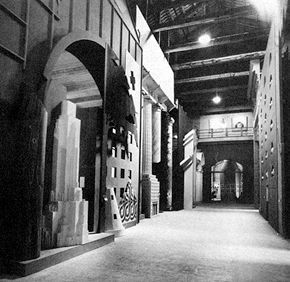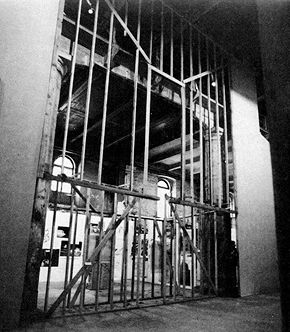
Since the 1970s the crisis in the building industry (and the consequent crisis of clientele) has reduced the architect, like the artist, to a parvenu on the cultural scene. The architect maintains a social position but has ceased to be able to leave any mark on the "real" environment; after a period of negotium (employment), there is now a state of otium (free time). To make up for this lack of activity, the architect is now occupied with the memory of building--rereading history, appropriating and transferring it to unrealized projects—into "ephemeral apparata for entering into architecture," that is, triumphal arches honoring architectonic fantasies. Limited in what he can build, the architect has instead entered the realm of imagination, where cultural and economic chains to a client have neither weight nor meaning. No longer constrained by any uniform morphology, the architect can take pleasure in assembling references to everything from archeology to Constructivism, or creating hyper-realist realizations. And so an irreverence toward history is born. The construction site has become a scenography workshop, and socially unrealizable architecture is transformed through plaster and theatrical wings from an illusory presence into a reality--the simulated becomes the “original,” that is, the authentic.
Post-modernism preaches the mythical and divine function of architecture as the highest of all sciences of building. It presumes a relation between architecture and architectonic teleology, and considers only well-known and primary principles: sacred ideas and entities, discovered in the past and in history. Critical considerations aside, the "Strada Novissima" of post-modernism is important precisely because it concretizes artificial and ephemeral architectural construction. It therefore questions all "exhibited" presentations, exposing them as fictions and symbolically celebrating the identity of an architecture that has no identity.
"Strada Novissima" accepts the presence of illusion and the absence of the authentic and identifiable. Every imaginary edifice can make reference to every other; all things reciprocally cancel each other out to exalt the sacred "writing" of architecture. All principles of construction can be drawn from this encyclopedia of historical references.
| |

In the end the most radical intervention is decidedly that of Frank Gehry, the California architect, who has refuted monumentalizations and imitations by proposing a wood-frame skeleton through which to view the 16th-century architecture of the arsenal "in perspective," thus turning this post-modernist rebirth into what might be called a "renaissance of the Renaissance."
. . .
Finally, the work tends toward a retro appropriation of history; it is as though Venturi’s Greek-style Pop facade or Scolari’s axonometric image gives a "contemporary" reading of history, seeing it not in its existential origins but according to an intellectual embalming. Every project is based, beyond the evidence of references (from Palladio to Loos, from Bernini to Malevich), on the temporal fracturing of individual facades, so that architectonic moments from classicism to modernism can coexist. The contamination and fragmentation of cultural inheritances breaks up historical linearity: one could compare it to collage. The architecture is made up of broken images, thereby running the risk of reducing built form to illustrative flatness.
Germano Celant, "Strada Novissima" in "The Presence of the Past" (Artforum: December 1980).
2017.08.01
Now switch off the sound and reverse the film
About Koolhaas's background in filmmaking much has been said, but the most important contribution to architecture that originates from his work in that fiels is the scenario. The scenario not only organizes the program of a building as a plot, but also gives the building itself a place in a larger plot. A plot is a literary, rather than a visual influence--a story that grows organically through the actiona and reactions of protagonists of a novel or a film. It gives a possible, mythological order to reality, but it is never reality itself, which is essentially chaotic. The awareness of this unreal literary order is expressed in Koolhaas's preference for the paradox and the oxymoron, which both connect seemingly different or even opposite phenomena.
| |
...
Koolhaas's architecture and urbanism also consist of a reading and extrapolation of tendencies he reaches in the present reality, but he is more concerned about the subconscious forces at work than about good intentions and ideal orders. His criticism consists of putting these forces on the agenda in the way a journalist or a writer would with a forgotten war or the cover-up of a political scandal: by going there, doing research, and reporting his findings. More and more, this research is becoming his most crucial contribution to architectural thinking.
Because of the many uncontrollable forces at work--forces largely related to sociology and psychology--and even a skepticism towards his own personal motives (which could very well be influenced by the same forces) Koolhaas realizes that it is meaningless and impossible to predict or control the future, which paradoxically is what architecture tried to do. Reality can only be given a possible explanation in retrospect; Delirious New York is a retroaactive manifesto and the conclusion is a fictional, literary proposal; S,M,L,XL is a novel that concludes with a film scenario and a P.S. in the form of a project--the Jussieu Library--that was never built.
Bart Lootsma, "Now switch off the sound and reverse the film..." in Hunch (No. 1: 1999).
2017.08.01
...no brief against the art of the past
Contemporary art, by contrast, has no brief against the art of the past, no sense that the past is something from which liberation must be won, no sense even that is is at all different as art from modern art generally. It is part of what defines contemporary art that the art of the past is available for such use as artists care to give it. What is not available to them is the spirit in which the art was made. The paradigm of the contemporary is that of the collage as defined by Max Ernst, with one difference. ernst said that collage is "the meeting of two distant realities on a plane foreign to them both." The difference is that there is no longer a plane foreign to distinct artistic realities, nor are those realities all that distant from one another. That is because the basic perception of the contemporary spirit was formed on the pronciple of a museum in which all art has a rightful place, where there is no a priori criterion as to what that art must look like, and where there is no narrative into which the museum's contents must all fit. Artist's today treat museums as filled not with dead art, but with living artistic options. The museum is a field available for constant rearrangement, and indeed there is an art form emerging which uses the museum as a repository of materials for a collage of objects arranged to suggest or support a thesis... But the genre is almost commonplace toda: the artist is given free run of the museum and organizes out of its resources exhibitions of objects that have no historical or formal connection to one another other than what the artist provides. In some way the museum is cause, effect, and embodiment of the attitudes and practices that define the post-historical moment of art...
Arthur C. Danto, After the End of Art: Contemporary Art and the Pale of History (1997), pp. 5-6.
| |
2017.11.08
Side by side with the novel...
Side by side with the novel in fact--with its average style, homogeneous space, and circumscribed temporal horizon: the solid form of 'the present'--side by side with the novel, and silently opposed to it, another great narrative begins to develop in nineteenth-century Europe (and in between Europe and the world): an epic form, in whose key scene--the Walpurgisnacht--a Babel of discordant voices pointss out how precarious is the cohabitation of the past and the future. Kraus, Döblin, Pound, Mann, Meyrink, Joyce; before then Melville and Flaubert; before still, Goethe: as it all begins with the gigantic mosaic of Faust, where a man of modernity must face the medieval and classical past, must learn to exorcise and conquer them, and finally (but never completely) must also learn to relinquish them. Museum der Weltliteratur, a recent critic has defined Faust; and it's true, Goethe's poem is the perfect text for a world which has crystalized in its museums a deep ambivalence towards the past. We should venerate the past as a sacred thing, the museum tells us--but after having secured it within well-guarded marble jails;42 we should acknowledge it as past, yet possibly endow it with a contemporary meaning as well. As within mythic bricolage, or Faust's allegory, in a museum, the signifieds of antiquity become the signifiers of Modernity; fase to fase with objects torn from their world, the european imagination acquires an extreme, at times irresponsible freedom with regard to historical materials. Would Mona Lisa have acquired a moustache has she not been inside a museum? And indeed, the great modernist myth of origins tells the story of a young painter, insude of the road to follow, who happens to be near the Trocadéro; he walks inside, and wanders for a while through its rooms crowded with outlandish objects. When Pablo Picasso's stroll is over, Cubism begins, with which everything else begins.
The museum and the avant-garde, unsuspectible accomplices in a violent reorganization of the past. But is it simply the past at stake, in nonsynchronism? The great nineteenth-century museums are located in London, Paris, Berlin, and are filled with objects taken from Greece, from the Roman Empire, Mediterranean Europe, taken by force to the north. And then Egypt, Assyria, Persia, India, China . . . As in Faust, in the archaeological museum time and space overlap: better, history becomes a trope for geography; the conquest of the past--the conquest of Helen of greece--a trope for the subjection of the world. And so, at the very hour of its birth, Goethe's cultural dream immediately forces a question upon us. Weltliteratur: world literature, human literature? Or the literature of imperialism?
Its capitals, after all, are England and France: the two major colonial powers (and a colonial museum is what the Trocadéro used to be). And the department stores, marchés aux puces, panpramas, ads, passages, world fairs, Baedekers, travel agents, catalogues, timetables . . . At the turn of the century, the entire planet is channelled into the Western metropolis (cosmopolis, as some decide to call it) and the truly epic, world-historical scope of many modernist works is indeed dependent on Europe's world domination. Unpleasant but true, imperialism plays for modernism the same role played by the French revolution for the realist novel; it poses the basic problem--how can such a heterogeneous and growing wealth be perceived? how can it be mastered?--addressed by collage, intertextuality, or the stream of consciousness. Without imperialism, in other words, we would have no modernism; its raw materials would be lacking, and also the challange that animated many of its inventions. And after all, what are Conrad and Elliot and Pound in search of? Certainly not of the small, cohesive England cherished a few years earlier by Henry James; but of the Merchant Navy, of the City, of the disorderly width of an Empire which is planetary embodiment of nonsychronism.
42. Museum der Weltliteratur is the expression used by Heinz Schaffer in his study of Goethe's poem (Faust Zweiter Teil, Die Allegorie des 19, Jahrhundrerts, Stuttgart 1981, p.107). On the analogi between the architecture of museums and that of jails, see the first part of The Lost Centre, by Hans Sedlmayr.
Franco Moretti, Distant Reading (London: Verso, 2013), p. 38-40.
|